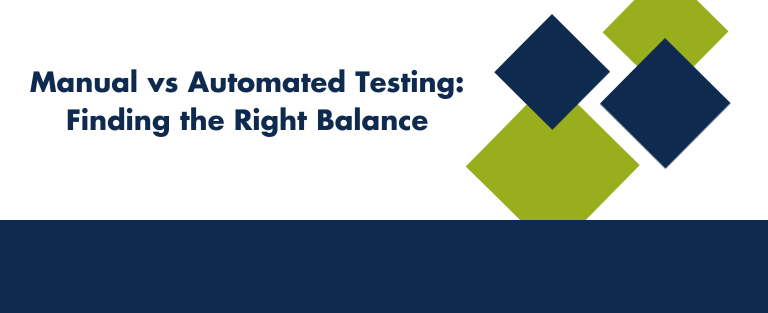Manual vs Automated Testing: Finding the Right Balance
Introduction
In the realm of software testing, the debate between manual and automated testing has long been a subject of discussion. Each approach offers unique benefits and drawbacks, making it essential for organizations to strike the right balance between the two. While automated testing provides efficiency and repeatability, manual testing offers human insight and adaptability. Finding the optimal mix of manual and automated testing is crucial for ensuring high-quality software delivery. In this blog, we’ll explore the strengths and weaknesses of both approaches and discuss strategies for achieving the right balance.
Understanding Manual Testing:
Manual testing involves the human execution of test cases without using automated tools. Testers interact with the software as end-users, exploring different scenarios, and validating functionality, usability, and other aspects. Manual testing allows testers to apply their intuition, creativity, and domain knowledge to identify bugs that automated scripts might overlook. It is particularly effective for exploratory testing, ad-hoc testing, and scenarios where user experience is critical.
Strengths of Manual Testing:
- Human Judgment: Testers can apply their critical thinking skills and domain expertise to identify complex issues that may be challenging to automate.
- Adaptability: Manual testers can quickly adjust test cases based on real-time feedback, changing requirements, or unexpected behavior.
- User Perspective: Manual testing enables testers to evaluate software from the end-user’s perspective, ensuring that meets usability and accessibility standards.
- Exploratory Testing: Manual testers can uncover unforeseen issues through exploratory testing, simulating real-world usage scenarios, and edge cases.
Weaknesses of Manual Testing:
- Time-consuming: Manual testing can be labor-intensive and time-consuming, especially for large or complex applications.
- Repetitive Tasks: Testers may find themselves repeating the same tests, leading to inefficiency and potential human error.
- Subjectivity: Manual testing results can vary based on the tester’s skills, experience, and biases, leading to inconsistent outcomes.
- Limited Scalability: Manual testing may struggle to keep pace with rapid development cycles or large-scale projects, leading to bottlenecks in the testing process.
Understanding Automated Testing:
Automated testing involves the use of software tools to execute pre-scripted tests, compare actual outcomes with expected results, and report discrepancies. Automated tests are typically faster, more repeatable, and less prone to human error compared to manual testing. They are well-suited for regression testing, performance testing, and scenarios with predictable inputs and outputs.
Strengths of Automated Testing:
- Efficiency: Automated tests can be executed quickly and repeatedly, allowing for faster feedback loops and accelerated release cycles.
- Repeatability: Automated tests produce consistent results, reducing the risk of human error and ensuring reliable test coverage.
- Scalability: Automated testing scales well with the size and complexity of the application, making it suitable for large-scale projects and continuous integration pipelines.
- Regression Testing: Automated tests excel at detecting regressions by quickly verifying that new code changes have not introduced unintended side effects.
Weaknesses of Automated Testing:
- Initial Setup and Maintenance: Developing and maintaining automated test scripts requires time, effort, and technical expertise, especially for dynamic or frequently changing applications.
- Limited scope: Automated tests may struggle to evaluate aspects such as user experience, visual design, or subjective quality criteria.
- False positives/negatives: Automated tests may produce false positives (reporting bugs that don’t exist) or false negatives (failing to detect actual bugs) due to imperfect test coverage or environmental factors.
- Cost: Implementing and managing automated testing tools and infrastructure can be expensive, especially for small or resource-constrained teams.
Finding the Right Balance:
Achieving the right balance between manual and automated testing involves considering various factors, including project requirements, team skills, budget constraints, and the nature of the application. Here are some strategies to help organizations find the optimal mix:
- Identify Suitable Test Scenarios: Determine which test scenarios are best suited for manual testing (e.g., exploratory testing, usability testing) and which can be automated (e.g., regression testing, performance testing).
- Prioritize Critical Areas: Focus automated testing efforts on critical functionalities, high-risk areas, and repetitive test cases to maximize ROI and test coverage.
- Invest in Automation Wisely: Invest in automation strategically, prioritizing tests that provide the most value and return on investment. Regularly review and update automated test suites to ensure relevance and effectiveness.
- Foster Collaboration: Encourage collaboration between manual testers, automation engineers, developers, and other stakeholders to leverage each other’s strengths and expertise.
- Continuously Evaluate and Evolve: Regularly assess the effectiveness of your testing approach and adjust the balance between manual and automated testing based on feedback, project dynamics, and changing requirements.
Conclusion:
As a prominent Salesforce consultant in USA, we find the right balance between manual and automated testing to ensure high-quality software delivery. By understanding the strengths and weaknesses of both approaches and adopting a strategic approach to testing, organizations can optimize their testing efforts, improve product quality, and deliver value to their customers.



